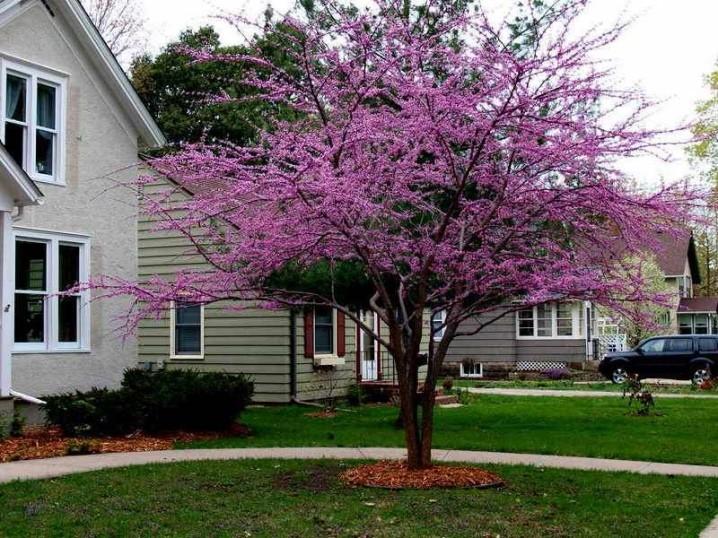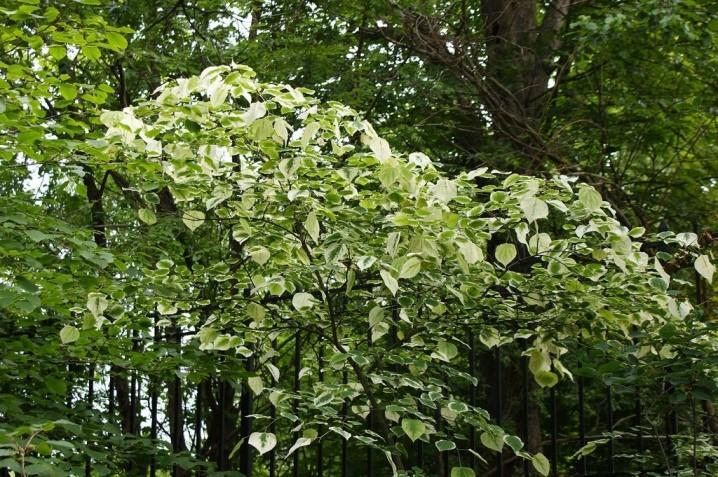Content
Cercis canadensis, also called purple grass, is a tree or tall shrub that grows for many years in the same place. It is one of the first to bloom in the middle - second half of April. It is exceptionally beautiful thanks to its spreading crown and a large number of inflorescences of rich pink color. How to plant and properly care for a tree is described in detail in this article.
Photo and description of Cercis canadensis
Canadian cercis (lat. Cercis Canadensis) is a perennial plant from the genus of the same name, belongs to the legume family. This is a fairly tall tree, reaching a height of 18 m (usually up to 9-10 m). The bark on the branches and trunks is black and gray. In this case, young shoots are red in color.
The crown of Cercis canadensis resembles a tent, very wide, spreading, reaching 10 m.The leaves are simple in shape, the color is bluish-green above and dull below. They are ovoid in shape, quite wide, reaching from 5 to 8-12 and less often 16 cm in length. The bases are heart-shaped, the apex is pointed, and pubescence is noticeable below. By autumn they begin to turn yellow.
Canadian cercis flowers appear in mid-spring. They are collected in bunches in small quantities (4-8 pieces). The color is light pink, often with a lilac tint. Depending on the variety of Canadian Cercis, the gamma may be different, for example, pure white. The petals reach only 1-1.2 cm in length. Inflorescences appear in very large quantities, making the tree look extremely attractive during flowering.
Frost resistance of Cercis canadensis
Cercis canadensis is a heat-loving plant, winter hardiness zone from 5 to 9. This means that the tree can withstand temperatures down to -23 °C (without shelter in open ground).

Cercis canadensis blooms in the second half of April
However, some varieties are quite winter-hardy, so they can be grown in central Russia (including the Moscow region), the Volga region and the south of the country.
Where does Cercis canadensis grow?
In nature, Cercis canadensis is found throughout North America (from New York in the north to Miami in the south). In the west, the range extends to the states of Texas and Nebraska. The southern border runs through the northern states of Mexico.
It is noteworthy that, despite the name, in Canada itself, cercis is found much less frequently than in the USA and Mexico.
When does Cercis canadensis bloom?
The flowering period occurs in the second half of April and the beginning of May.The specific period depends on the characteristics of the region and the weather conditions of the season. The buds bloom within a month.
In the first half of autumn (until October), Cercis canadensis forms fruits. They are long beans (up to 10 cm), inside of which there are brown seeds. They do not fall off on their own, so if you do not remove them, they will hang for 1-2 years.
The best varieties
Breeders have developed several varieties of Canadian Cercis. Some of them are characterized by high winter hardiness, which makes it possible to grow trees in different Russian regions. Some of the most beautiful varieties include:
- Cercis Alba is an interesting crop that produces pure white flowers. In appearance it somewhat resembles a blossoming apple tree.
- Pink charm is a classic variety. It is distinguished by flowers of a rich pink hue.
- Silver cloud – This Canadian variety boasts whitish-green foliage. Thanks to this, it retains its decorative effect even after flowering has ended.
- Ruby Falls is a variety with drooping shoots. It makes it possible to create a very beautiful crown even with the help of simple pruning.
- Forest Pansy is a low shrub with dark leaves. Valued for its wide crown and attractive appearance, which lasts until late autumn.
- Little Woody is a shrub up to 3 m high with purple flowers. The crown is compact, so even in a small area you can plant several plants at once, creating a beautiful composition.
- A less common variety of Canadian redberry is Rising Sun. It is not characterized by high winter hardiness, but it fascinates with its beauty.
How to plant Cercis canadensis
When choosing a place to plant Cercis canadensis, it is necessary to take into account the growing conditions. The tree grows normally in open places, and it is advisable to create a small shadow from a fence, house or tall bush. It is recommended to plant crimson on the south or southwest side, optimally next to the fence.
Among other requirements for location and soil, the following should be listed:
- fertile and fairly loose soil with a slightly acidic or neutral reaction pH = 6-7;
- lack of through winds, especially from the north side of the garden;
- absence of stagnation of water - lowlands are excluded, if necessary, an additional layer of soil is poured to form a small hill.
It is advisable to start planting Canadian cercis in early April. Moreover, it is better to prepare the site the day before in the fall. To do this, dig up the ground and add compost or humus in an amount of 5-7 kg per square meter.
It is worth considering that the tree does not grow well in an acidic environment. Therefore, if the pH is less than 5.5 (can be measured with a device or indicator paper), it is necessary to add lime up to 200-300 g per 1 m2. It also happens that the soil is too dense. Then, when digging, it is recommended to cover it with sawdust or sand (2-3 kg for the same area).
The landing process itself looks like this:
- Mark a planting hole with a depth and diameter of 50-70 cm. The distance to the nearest building or neighboring tree or shrub should be at least 5 m.
- Place a layer of small stones, such as pebbles or expanded clay, at the bottom.
- Next, plant the seedling in the center, trying to carefully straighten the roots and preserve the earthen lump.
- Sprinkle with fertile soil (you can take garden soil and mix with peat, humus and sand in a ratio of 2:1:1:1).
- Compact the soil so that the root collar of the Canadian cercis remains flush with the surface and does not go to depth.
- Water with settled water and after a few days mulch with sawdust, hay, straw or other materials.

Canadian cercis seedlings are usually planted at a distance of at least 5 m from each other
How to care for Cercis canada
To grow a beautiful Canadian cercis in the Moscow region, it is important to consider several recommendations for planting and care. The tree is quite demanding in terms of the conditions created, but if desired, both a professional and a novice gardener can cope with its cultivation.
Particular attention should be paid to young plants in the first 2-3 years of life. Despite the fact that the Canadian cercis is drought-resistant, seedlings should be given water at least once a week. Mature trees are watered as needed 2-3 times a month, based on the weather forecast.
Fertilizers are given to the Canadian cercis regularly:
- In April, water with liquid humate or mullein infusion diluted in a ratio of 1:10.
- At the end of June, nitrogen fertilizer is given, for example, ammonium nitrate (20 g per 10 l).
- At the end of August, it is necessary to feed with complex mineral fertilizer with phosphorus and potassium compounds or water with an infusion of wood ash (200 g per 10 l).
In the first 5-7 years after planting, it is very important to monitor the crown of the Canadian cercis. In early spring, sanitary pruning is regularly done - diseased, dry, frozen branches are removed. Moreover, even young shoots must be shortened by a third of their length.
It is recommended to trim those shoots that grow inward, which clearly thicken the crown. They also remove shoots, which greatly spoil the appearance and can interfere with other plants.
Periodically it is necessary to loosen the tree trunk circle. The soil can be dug up to 10 cm, since the root system of the plant lies quite deep. At the same time, weeding is also done. To ensure that there are as few weeds as possible, lay a layer of mulch and change it as necessary.

Regular application of fertilizer guarantees lush flowering of the Canadian cercis
Diseases and pests
Cercis canadensis is rarely affected by diseases. Excessive watering combined with insufficient fertilizing can provoke various types of infections, including powdery mildew or gray rot. To prevent this, it is recommended not only to comply with the watering norm, but also to carry out preventive treatments. In early spring, the Cercis canadensis shrub is sprayed with any fungicide:
- "Ordan";
- "Ridomil Gold";
- "Fundazol";
- "Bordeaux mixture"
Of the insects, aphids are especially dangerous, which often settle on trees in entire colonies and feed on the sap of young leaves. To prevent and destroy pests, the Canadian cercis bush is treated with high-quality insecticides, for example:
- "Ephoria";
- "Colorado";
- "Agravertine";
- "Vertimek".
Spraying is best done at sunset, and according to the forecast there should be no precipitation or strong wind. If the tree is tall, you will need a stepladder for effective processing.
How to propagate Cercis canadensis
Cercis canadensis propagates by seeds and vegetatively - by cuttings. The last option is simpler, so it is used much more often. Both techniques are described in the following sections.
Growing Cercis canadensis from seeds
Growing cercis from seeds is not easy, since the process includes several stages extended over time:
- The collected beans are placed in a bag made of paper or natural fabric.
- Store in the refrigerator until next spring (this procedure is called stratification).
- At the beginning of spring, they are sown in boxes with fertile soil, watered well and placed in a lighted place.
- Cover with film to create greenhouse conditions, and remove it after germination.
- Continue to water and feed; if necessary, Cercis canadensis seedlings are planted after the formation of several leaves.
- They grow at home throughout the year, and next spring they are transferred to open ground.
Propagation of Cercis canadensis by cuttings
Cuttings are taken from young branches 2-3 years old. Moreover, each person must have at least two kidneys. They must be cut immediately after leaf fall, and then buried to a depth of 15 cm, positioned at an angle of 45 degrees.
In the spring, provide good watering and feed with complex mineral fertilizer. Shoots should appear in May. In October they are carefully mulched, and the next spring the seedlings are transferred to a permanent place.
Photos in landscape design
Cercis canadensis looks good in single plantings, especially against the backdrop of a lawn, not far from the house, on the shore of a reservoir. If space allows, you can plant several trees at a distance of 5-6 m from each other, creating a beautiful alley.
Below are options for using Canadian cercis in garden design with photos and descriptions:
- Single planting against a lawn background.
- Landing at the entrance to the house.
- Next to the path.
- Composition with conifers, alley design.
- Another option for planting next to the path.
Conclusion
Cercis canadensis is one of the best ornamental plants, suitable for the middle zone, the Volga region and neighboring regions. It is distinguished by a wide variety of both size and color of flowers. For small areas it is better to choose low-growing varieties, and for spacious areas, on the contrary, tall ones. Looks beautiful both in a single planting and in compositions.
Reviews of Canadian cercis



















